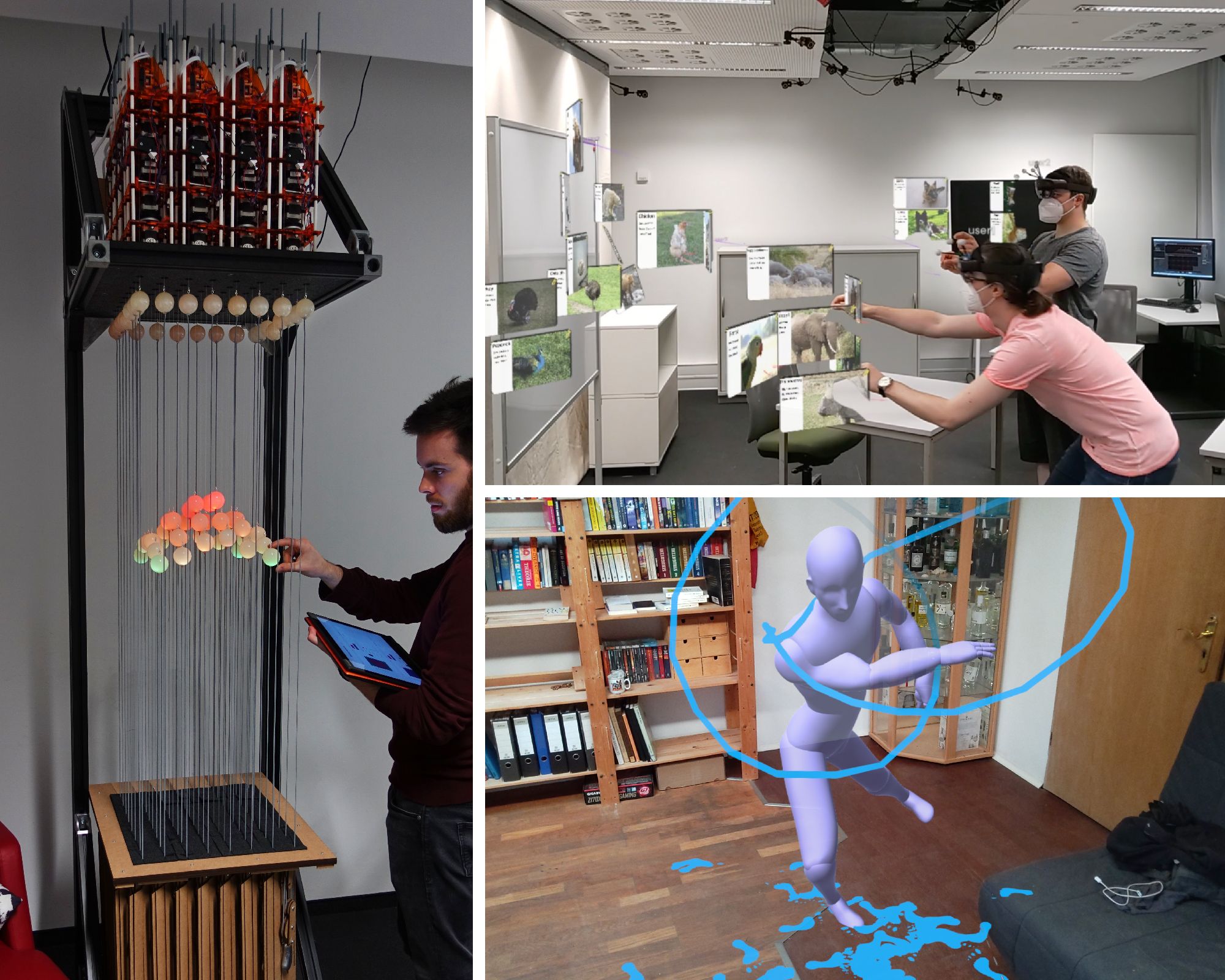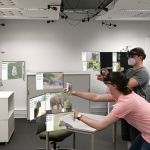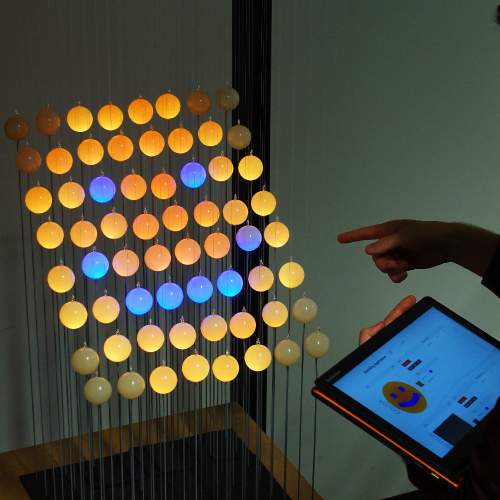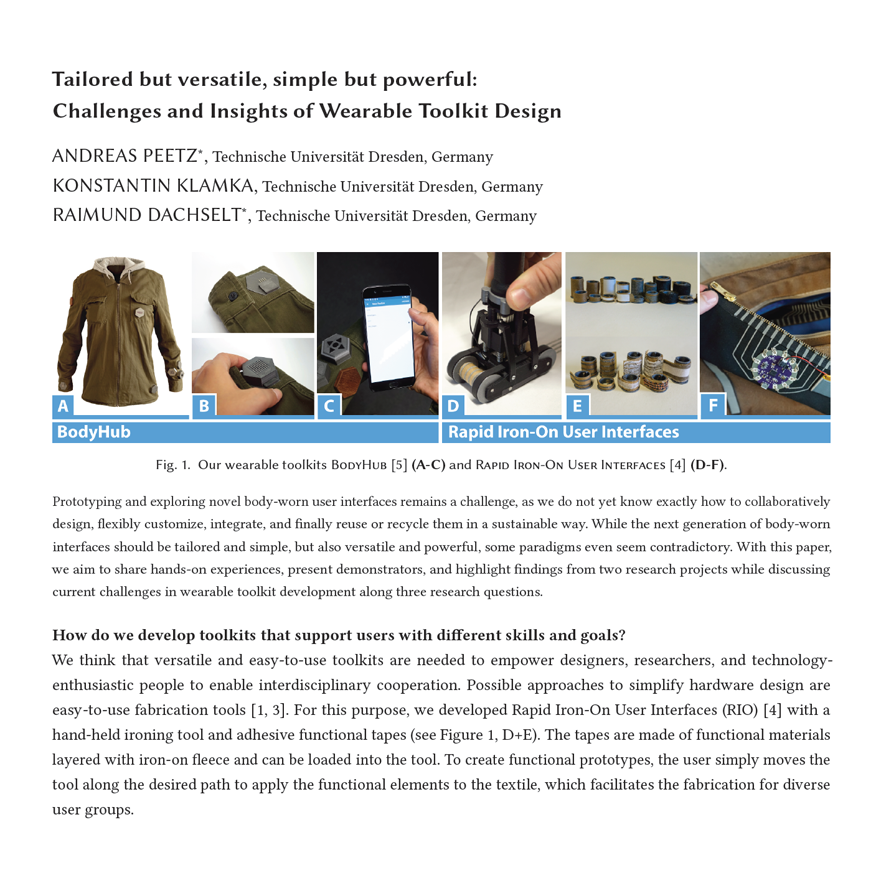We are happy to announce, that we contribute three full papers to this year’s ACM Conference on Human Factors in Computing Systems (CHI). The ACM CHI is the biggest and most prestigious conference in the field of human-computer interaction and will take place in New Orleans, LA, USA from April 30 to May 05, 2022. Five colleagues of our team will fly to New Orleans to present our results and meet HCI researchers from around the world.
Information about the research projects, as well as the full papers, video figures, and supplementary material, are already available on the respective project pages.
STRAIDE: A Research Platform for Shape-Changing Spatial Displays based on Actuated Strings
STRAIDE is a String-Actuated Interactive Display Environment that allows to explore the promising potential of shape-changing interfaces for casual visualizations. At the core, we envision a platform that spatially levitates elements to create dynamic visual shapes in space. We conceptualize this type of tangible midair display and discuss its multifaceted design dimensions. Through a design exploration, we realize a physical research platform with adjustable parameters and modular components. For conveniently designing and implementing novel applications, we provide developer tools ranging from graphical emulators to in-situ augmented reality representations. To demonstrate STRAIDE’s reconfigurability, we further introduce three representative physical setups as a basis for situated applications including ambient notifications, personal smart home controls, and entertainment. They serve as a technical validation, lay the foundations for a discussion with developers that provided valuable insights, and encourage ideas for future usage of this type of appealing interactive installation.
Where Should We Put It? Layout and Placement Strategies of Documents in Augmented Reality for Collaborative Sensemaking
In this work, we report a qualitative study investigating the effect of office environments and work styles on virtual content placement, layout strategies, and sensemaking workflows in Augmented Reality (AR). Future offices are likely reshaped by AR, however, it is unclear how physical surroundings and co-located collaboration influence the spatial organization of virtual content. Therefore, we conducted an empirical study (N=28) using a typical sensemaking task (document classification) in AR. Our results indicate that users require physical objects like furniture for virtual content placement in AR for data sensemaking and for collaboration, regardless of room settings. In particular, furniture can be used as landmarks, which helps users with orientation in the immersive environment and facilitate collaborative communication. Also, collaborating participants tend to use furniture despite personal layout preferences. Lastly, we identified different placement and layout strategies and proposed design implications for future AR-enabled office and immersive sensemaking applications.
AvatAR: An Immersive Analysis Environment for Human Motion Data Combining Interactive 3D Avatars and Trajectories
With AvaTAR we present an immersive analysis environment for the in-situ visualization of human motion data, that combines 3D trajectories, virtual avatars of people’s movement, and a detailed representation of their posture. Our visualizations are embedded directly into the real environment and enable analysts to perceive, what a person looked at or what surfaces they touched. We utilize an avatar’s body parts for accessing and manipulating visualizations using mid-air interaction. AvatAR combines an AR HMD with a tablet to provide both mid-air and touch interaction for system control, as well as an additional overview to help users navigate the environment. In our paper, we report on the prototype implementation we develop and present several scenarios to show how AvatAR can enhance the analysis of human motion data by making data not only explorable, but experienceable.
In addition, Andreas Peetz will be presenting the workshop article “Tailored but versatile, simple but powerful: Challenges and Insights of Wearable Toolkit Design”, which was created together with Konstantin Klamka and Raimund Dachselt, in the workshop called Developing Toolkits for Exploring Wearable Designs.
Contributions to CHI 2022
@inproceedings{luo2022arsensemaking,
author = {Weizhou Luo and Anke Lehmann and Hjalmar Widengren and Raimund Dachselt},
title = {Where Should We Put It? Layout and Placement Strategies of Documents in Augmented Reality for Collaborative Sensemaking},
booktitle = {Proceedings of the 2022 CHI Conference on Human Factors in Computing Systems},
series = {CHI '22},
year = {2022},
month = {4},
location = {New Orleans, LA, USA},
numpages = {16},
doi = {10.1145/3491102.3501946},
publisher = {ACM},
address = {New York, NY, USA},
keywords = {spatiality, spatial layout, content organization, sensemaking, affordance, qualitative user study, Augmented Reality, Mixed Reality, collaborative sensemaking}
}List of additional material
@inproceedings{Engert2022,
author = {Severin Engert and Konstantin Klamka and Andreas Peetz and Raimund Dachselt},
title = {STRAIDE: A Research Platform for Shape-Changing Spatial Displays based on Actuated Strings},
booktitle = {Proceedings of the 2022 CHI Conference on Human Factors in Computing Systems},
series = {CHI '22},
year = {2022},
month = {4},
isbn = {978-1-4503-9157-3/22/04},
location = {New Orleans, LA, USA},
numpages = {16},
doi = {10.1145/3491102.3517462},
publisher = {ACM},
address = {New York, NY, USA},
keywords = {Prototyping Platform, Spatial Display, Shape-Changing Interface, Tangible Interaction, Casual Visualization, Data Physicalization}
}List of additional material
@inproceedings{Reipschlaeger2022,
author = {Patrick Reipschl\"{a}ger and Frederik Brudy and Raimund Dachselt and Justin Matejka and George Fitzmaurice and Fraser Anderson},
title = {AvatAR: An Immersive Analysis Environment for Human Motion Data Combining Interactive 3D Avatars and Trajectories},
booktitle = {Proceedings of the 2022 CHI Conference on Human Factors in Computing Systems},
series = {CHI '22},
year = {2022},
month = {4},
isbn = {978-1-4503-9157-3/22/04},
location = {New Orleans, LA, USA},
numpages = {15},
doi = {10.1145/3491102.3517676},
publisher = {ACM},
address = {New York, NY, USA},
keywords = {Visualisation, augmented/mixed reality, human motion data, analysing space utilization, motion analysis, Immersive Analytics}
}List of additional material
@article{fixme,
author = {Andreas Peetz and Konstantin Klamka and Raimund Dachselt},
title = {Tailored but versatile, simple but powerful: Challenges and Insights of Wearable Toolkit Design},
booktitle = {CHI 2022 Workshop on Toolkits \& Wearables - Developing Toolkits for Exploring Wearable Designs},
year = {2022},
month = {04},
location = {New Orleans, LA, USA},
keywords = {wearable toolkits, prototyping, e-textile, modular systems}
}List of additional material




